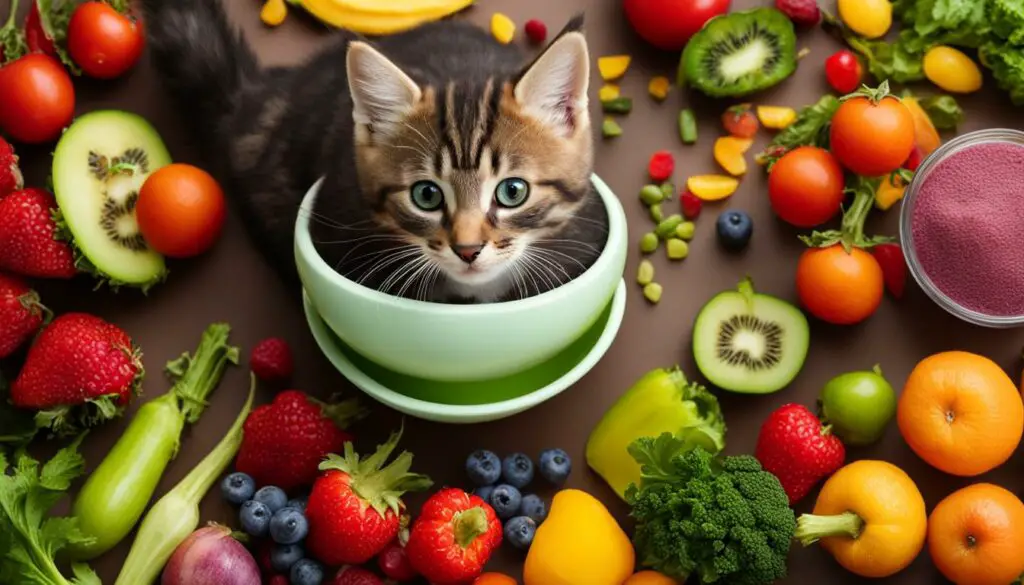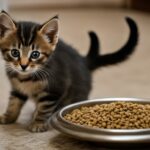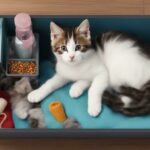Feeding your kitten the right nutrition is essential for their growth and development. While some cat foods claim to be suitable for all life stages, including kittens, it’s important to understand their specific needs. Kittens require a diet specially formulated to meet their unique nutritional requirements. In this article, I will explain why all stages cat food may not be the best choice for your kitten and provide insights on how to ensure they receive the proper nutrition they need.
Key Takeaways:
- All stages cat food may not provide the specific nutritional needs of kittens.
- Kittens require higher levels of protein, amino acids, and minerals for rapid growth.
- Feeding specially formulated kitten food ensures proper nutrition during their early stages.
- Choose high-quality kitten food recommended by veterinarians.
- Monitor your kitten’s growth and consult with your veterinarian for any concerns.
Why Kittens Have Different Nutritional Needs
When it comes to the nutritional needs of kittens, it’s important to understand that they have unique requirements due to their stage of life. Kittens experience rapid growth during the first few weeks of life, and this growth requires higher energy levels compared to adult cats. In fact, their weight can double or even triple during this time. To support this growth, kittens need a diet that provides them with the necessary nutrients.
One of the key differences in the nutritional needs of kittens is their requirement for protein. Protein plays a crucial role in their growth and development, as it is the building block for their muscles and tissues. Kittens should receive about 30% of their energy from protein, which is significantly higher than the protein requirement for adult cats. Additionally, kittens have a higher demand for amino acids and minerals, which are necessary for their overall health and development.
Feeding your kitten specially formulated kitten food is essential to ensure they receive the right balance of nutrients. Kitten food is designed to meet their specific nutritional needs and provide them with the energy, protein, amino acids, and minerals they require. By feeding your kitten a diet tailored to their needs, you can promote healthy growth and development, setting them up for a happy and active life.
“Kittens have higher energy needs and require more protein, amino acids, and minerals compared to adult cats.”

Why Kittens Have Different Nutritional Needs
During the first few weeks of life, kittens experience rapid growth and have high energy needs. Their weight may double or even triple during this time, and they require triple the energy needs of adult cats. Kittens also have a higher requirement for protein, amino acids, and minerals compared to adult cats. Protein is the main building block for growth, and kittens should get about 30% of their energy from protein. These nutritional needs make it important to feed them specially formulated kitten food.
The Importance of High-Quality Kitten Food
When it comes to nourishing your adorable kitten, providing them with high-quality food is essential. Choosing a reputable company that produces nutritionally balanced kitten food is crucial for their overall health and well-being. By selecting a trusted brand, you can ensure that your kitten receives the proper nutrients they need for optimal growth and development.
High-quality kitten food meets the nutritional requirements established by organizations like the American Association of Feed Control Officials (AAFCO) or has complete and balanced nutrition based on AAFCO feeding trials. This means that the food provides all the essential vitamins, minerals, and nutrients your kitten needs without the need for additional supplements.
“Feeding your kitten high-quality food is the key to their health and happiness.” – Veterinary Nutritionist Dr. Emily Jones
Reputable companies invest in research and development to ensure that their kitten food is formulated specifically to meet the unique nutritional needs of growing cats. These companies use high-quality ingredients that are easily digestible and provide the necessary proteins, amino acids, and minerals that support your kitten’s rapid growth and development.
| Benefits of High-Quality Kitten Food | Consequences of Poor-Quality Kitten Food |
|---|---|
|
|
Feeding your kitten high-quality food not only ensures their immediate health but also lays the foundation for their long-term well-being. By providing them with the nutrients they need during their early stages of life, you’re setting them up for a happy and healthy adulthood.
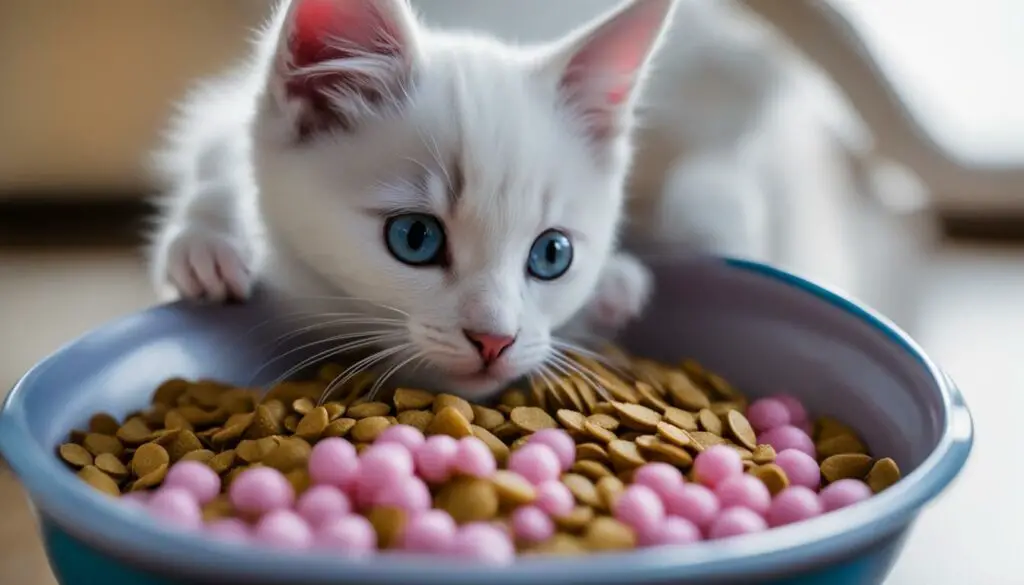
The Role of High-Quality Ingredients
High-quality kitten food is made with premium ingredients that are carefully selected to provide optimal nutrition. These ingredients are sourced from trusted suppliers and undergo rigorous testing to ensure their safety and quality. By using high-quality ingredients, reputable companies can create a product that is not only nutritious but also highly palatable, encouraging even the pickiest of kittens to enjoy their meals.
Feeding Guidelines for Kittens
Feeding your kitten according to a proper schedule is essential for their health and well-being. Most kittens have high energy needs and smaller stomach capacities, so they may prefer to eat smaller, frequent meals throughout the day. It is recommended to feed kittens at least three to four meals a day to ensure they receive enough nutrients to support their rapid growth and development. Additionally, providing canned food in their diet, especially for very young kittens, can be beneficial as it is easier for them to chew and digest.

As kittens grow older, their nutritional requirements and feeding habits may change. Around four to six months of age, you can start transitioning them to two meals a day. This allows them to adjust to a more typical feeding schedule for adult cats. However, it is important to monitor your kitten’s weight and adjust portion sizes accordingly to prevent overfeeding or weight gain.
When it comes to kitten treats, it’s important to follow the “10% calorie rule.” Treats should make up less than 10% of your kitten’s total daily calorie intake. Excessive treats can lead to weight gain and nutritional imbalances. It’s also crucial to choose healthy and kitten-friendly treats, avoiding any toxic foods or substances that could be harmful to their health. By following these feeding guidelines and providing your kitten with a balanced diet, you can ensure they grow into a healthy and happy adult cat.
Transitioning Kittens to New Food
Transitioning your kitten to a new food can be a delicate process that requires patience and careful consideration. Abrupt changes in diet can often lead to stomach upset or refusal to eat, so it’s best to introduce the new food gradually. The gradual transition allows your kitten’s digestive system to adjust to the new food, ensuring a smooth and successful change.
To start the transition, mix the new food with the old food in the same bowl. Begin with a small amount of the new food and gradually increase the ratio of new food to old food over a period of four to seven days. This gradual shift allows your kitten to become familiar with the taste and texture of the new food while still providing the comfort of their familiar food.
Throughout the transition, monitor your kitten’s response to the new food. Observe their eating habits, stool consistency, and overall demeanor. If you notice any signs of discomfort or digestive issues, consult with your veterinarian for guidance. Their expertise can help ensure a successful transition and address any concerns you may have.
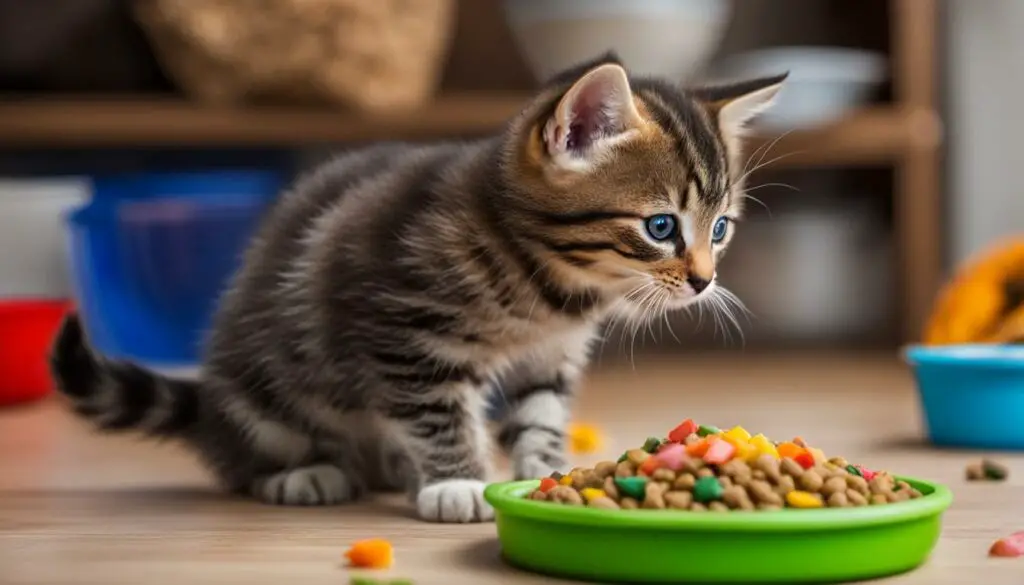
Benefits of a gradual transition:
- Reduces the risk of digestive upset
- Allows your kitten to become accustomed to the taste and texture of the new food
- Provides a smoother transition for their sensitive digestive system
- Allows you to monitor their response and adjust accordingly
Remember, every kitten is unique, and their response to a dietary change may vary. It’s important to be patient and attentive during the transition process, ensuring your kitten’s health and well-being. By following these guidelines and consulting with your veterinarian, you can successfully transition your kitten to a new food and provide them with optimal nutrition.
The Role of Free-Feeding and Portion Control
When it comes to feeding kittens, the role of free-feeding and portion control can greatly impact their overall health and well-being. Free-feeding, which involves making unlimited food available to kittens all day long, is a suitable option for young kittens who have high energy needs and small stomach capacity. It allows them to eat little and often, preventing hunger strikes and ensuring they receive the necessary nutrition throughout the day. However, it’s important to note that free-feeding is not recommended for overweight or obese kittens, as measured portions are necessary to control their food intake and prevent excessive weight gain.
Preventing obesity in kittens is crucial, as it can lead to various health issues, including diabetes, arthritis, and heart disease. Portion control plays a vital role in managing their calorie intake and maintaining a healthy weight. Monitoring your kitten’s weight regularly and adjusting their feeding routine accordingly is important. If you notice that your kitten is becoming overweight, it may be necessary to reduce their food portions or switch to a weight management cat food formula.
Spaying and neutering can also increase the risk of obesity in kittens. These procedures can lead to changes in metabolism and hormone levels, causing cats to become more susceptible to weight gain. Therefore, it’s important to establish portion control and monitor your kitten’s weight closely after spaying or neutering. Consult with your veterinarian for personalized feeding guidelines and recommendations to ensure your kitten maintains a healthy weight throughout their life.
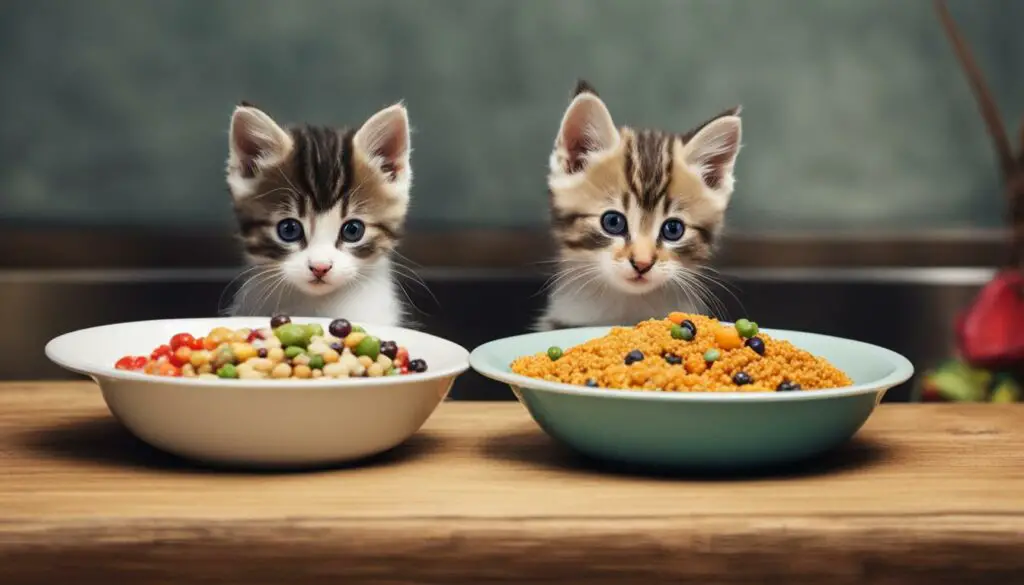
Benefits of Free-Feeding and Portion Control for Kittens
Both free-feeding and portion control have their advantages when it comes to feeding kittens. Here are the benefits of each:
- Free-Feeding: Allows kittens to eat small, frequent meals, mimicking their natural feeding behavior. Prevents hunger strikes and ensures they receive the necessary nutrition throughout the day. Suitable for kittens with high energy needs and small stomach capacity.
- Portion Control: Helps manage calorie intake and prevent obesity in kittens. Allows for personalized feeding based on individual needs and prevents overeating. Important for maintaining a healthy weight and overall well-being.
Choosing the Right Feeding Method
Deciding whether to free-feed or implement portion control depends on your kitten’s individual needs and health status. Consult with your veterinarian to determine the best feeding method for your kitten. They will consider factors such as age, weight, activity level, and any health conditions to provide personalized recommendations. Remember, the goal is to ensure your kitten receives the right amount of nutrition while maintaining a healthy weight throughout their life.
| Feeding Method | Advantages | Disadvantages |
|---|---|---|
| Free-Feeding | – Mimics natural feeding behavior – Prevents hunger strikes – Suitable for kittens with high energy needs |
– Not recommended for overweight or obese kittens |
| Portion Control | – Manages calorie intake – Prevents obesity – Allows for personalized feeding |
– Requires monitoring and adjustment – May lead to hunger between meals for some kittens |
Homemade Diets and Supplements for Kittens
When it comes to feeding kittens, some pet owners may consider homemade diets as an alternative to commercial kitten food. While homemade diets can be an option, it’s important to use caution and ensure they are properly formulated by a reputable nutritionist. Homemade diets, especially all-meat diets, can be low in calcium and lead to a mineral imbalance that affects a growing kitten’s health. If you choose to feed a homemade diet, it’s crucial to consult with a professional to ensure it meets all the necessary nutritional requirements.
Supplements for kittens are another aspect to consider. Like homemade diets, supplements should only be used if recommended by your veterinarian. Kittens receiving a balanced diet of commercial kitten food generally do not require additional supplements. However, if your veterinarian determines that your kitten has specific nutritional needs or deficiencies, they may recommend supplements to help meet those requirements. It’s important to follow your vet’s advice and not to give your kitten any supplements without their guidance.
Before making any changes to your kitten’s diet or introducing supplements, it’s essential to consult with your veterinarian. They can provide expert guidance based on your kitten’s individual needs. Remember, proper nutrition is crucial for a kitten’s growth and development, and seeking professional advice will ensure you’re providing the best possible care for your furry friend.
| H2: Homemade Diets and Supplements for Kittens | |
|---|---|
| Key Points | |
| Homemade diets for kittens should be properly formulated by a reputable nutritionist to avoid mineral imbalances. | |
| Supplements for kittens should only be used if recommended by a veterinarian. | |
| Consult with a veterinarian before making any changes to your kitten’s diet or introducing supplements. |
Signs of a Healthy Kitten
As a responsible kitten owner, it’s essential to monitor your furry friend’s health to ensure they’re thriving. Here are some key signs that indicate a healthy kitten:
- Steady Weight Gain: A healthy kitten will experience consistent weight gain as they grow. Regularly weigh your kitten and consult a veterinarian if you notice any drastic changes.
- Glossy Coat: A shiny and lustrous coat is a clear indicator of a healthy kitten. A well-nourished diet promotes a healthy skin and coat condition.
- Alertness: Healthy kittens are typically curious and alert. They should be actively exploring their environment, playing, and displaying an overall sense of vitality.
Keep in mind that these signs are general indicators of good health, but it’s always a good idea to schedule regular check-ups with your veterinarian to ensure your kitten is growing and developing as expected.
| Signs of a Healthy Kitten | Important Indicators |
|---|---|
| Steady Weight Gain | Regularly monitor weight and consult a veterinarian if there are concerns about weight loss or stagnation. |
| Glossy Coat | A shiny and smooth coat suggests a healthy diet and proper grooming. |
| Alertness | An active and engaged kitten indicates good health and vitality. |
Remember, age, breed, and individual characteristics may influence what is considered normal for your specific kitten. If you have any concerns about your kitten’s health or notice any changes in behavior or appearance, it’s always best to consult with your veterinarian for professional advice.
Introducing Textures and Flavors to Kittens
When it comes to feeding kittens, it’s important to introduce them to a variety of textures and flavors early on. This helps prevent them from becoming picky eaters and ensures they have a well-rounded diet. Kittens, like adult cats, have their own preferences when it comes to food textures. Some may prefer wet or moist food, while others may enjoy the crunch of dry kibble. By exposing them to different textures, you can help them develop a more diverse palate and ensure they are receptive to different types of food in the future.
Switching up the flavors of your kitten’s food can also be beneficial. Cats, including kittens, can get bored with the same flavor over time. By offering them a variety of flavors, you can keep mealtime exciting and interesting for them. However, it’s important to make any changes gradually to avoid stomach upset or refusal to eat. Start by mixing a small amount of the new flavor with the current food, gradually increasing the amount of the new flavor while decreasing the old one. This will help your kitten adjust to the new taste without any issues.
Every cat is unique, and their texture preferences may vary. Some kittens may prefer the smoothness of pâté, while others may enjoy the texture of minced or chunky food. It’s important to observe your kitten’s eating habits and preferences to determine the textures they enjoy the most. By providing a variety of options and paying attention to their responses, you can tailor their diet to their individual preferences and ensure they are satisfied during mealtime.
| Texture Preference | Feeding Option |
|---|---|
| Smooth and Pâté-like | Wet or moist kitten food |
| Minced or Chunky | Mixed texture kitten food |
| Crunchy | Dry kibble or treats |
Remember, introducing different textures and flavors to your kitten’s diet is not only beneficial for their taste preferences but also helps ensure they receive a well-balanced and nutritious diet. By offering a variety of options, you can provide them with the necessary nutrients while keeping their meals interesting and enjoyable.
Feeding Guidelines for Adult Cats
As your kitten transitions into adulthood, it’s important to adjust their feeding schedule to meet their changing needs. Most adult cats can be fed twice a day, providing them with a consistent routine and ensuring they receive adequate nutrition throughout the day. However, it’s crucial to monitor their weight and adjust portion sizes accordingly to prevent overfeeding and obesity.
Along with a regular feeding schedule, weight control is essential for adult cats. Obesity can lead to various health problems, including diabetes, joint issues, and a decreased lifespan. To maintain a healthy weight, it’s important to measure their food portions accurately and avoid free-feeding. Consult with your veterinarian to determine the appropriate portion size for your cat based on their age, activity level, and overall health.
While treats can be given to adult cats as a way to reward or bond with them, it’s important to be mindful of their calorie intake. Treats should make up less than 10% of their total calorie intake to prevent excessive weight gain. Opt for healthy treat options specifically designed for cats, and avoid feeding them table scraps or foods that can be toxic to them. If you have any concerns about your cat’s diet or weight, consult with your veterinarian for guidance and recommendations.
Table: Recommended Feeding Guidelines for Adult Cats
| Age | Feeding Schedule | Portion Size |
|---|---|---|
| 1-7 years | Twice a day | According to weight and activity level |
| 8-10 years | Twice a day | Adjusted portion size based on weight and activity level |
| 11+ years | Twice a day | Adjusted portion size based on weight, activity level, and any age-related health conditions |
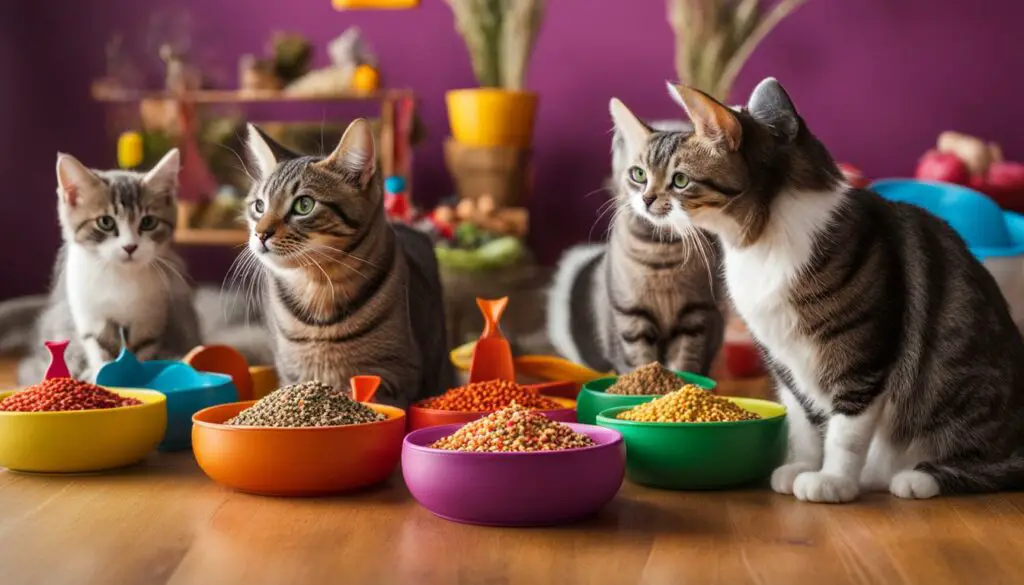
The Role of Treats in an Adult Cat’s Diet
As a cat owner, you may wonder how treats fit into your adult cat’s diet. Treats can be a great way to bond with your feline friend and provide them with a little extra something special. However, it’s important to remember that treats should be given in moderation and should not make up a significant portion of your cat’s daily calorie intake.
When it comes to calorie intake from treats, it’s best to follow the “10% calorie rule.” This means that treats should make up less than 10% of your cat’s total daily calorie intake. By keeping treats to a small percentage of their overall diet, you can help prevent excessive weight gain and maintain a balanced nutrition for your cat.
When choosing treats for your adult cat, opt for healthy options that provide some nutritional value. Look for treats that are low in calories and fat, and avoid treats that are high in fillers or artificial ingredients. Some healthy treat options for cats include freeze-dried meat, cooked chicken or turkey chunks, or even small pieces of fresh fruits and vegetables like blueberries or carrots. Just be sure to introduce new treats gradually and monitor your cat for any signs of digestive upset.
Remember, treats should complement your cat’s regular diet and not replace it. Always consult with your veterinarian about the best treats and feeding guidelines for your specific cat, taking into consideration their age, weight, and any dietary restrictions they may have. With the right approach, treats can be a fun and rewarding part of your cat’s daily routine.
| Treat Options | Calories per Treat | Features |
|---|---|---|
| Freeze-Dried Meat | 2-5 calories | High in protein, no fillers or artificial ingredients |
| Cooked Chicken or Turkey Chunks | 10-15 calories | Lean and easily digestible protein |
| Fresh Fruits and Vegetables | Varies depending on the fruit or vegetable | Low in calories and provide vitamins and minerals |
Conclusion
In conclusion, it is essential to prioritize proper nutrition when it comes to feeding your kitten. While some all stages cat food may be labeled as suitable for kittens, it is best to opt for specially formulated kitten food. Kittens have unique nutritional needs due to their rapid growth and high energy requirements. Feeding them kitten food packed with higher levels of protein, amino acids, and minerals ensures they receive the necessary nutrients for optimal development.
When choosing cat food for your kitten, it is vital to select high-quality options from reputable companies. Look for labels that meet the nutritional requirements set by organizations like the American Association of Feed Control Officials (AAFCO) or those that have undergone AAFCO feeding trials to guarantee complete and balanced nutrition. By providing your kitten with high-quality food, you can ensure their well-being and overall health.
Feeding guidelines should be followed to establish a healthy routine for your kitten. Offering them multiple meals a day, especially during their early stages, helps accommodate their high energy needs. Gradually transitioning to a new food and introducing different textures and flavors can prevent picky eating habits as they get older. Additionally, monitoring their weight and adjusting portion sizes accordingly is crucial for preventing obesity in adult cats.
In summary, giving your kitten the right nutrition is vital for their growth and development. Specially formulated kitten food, high-quality options, and following feeding guidelines are key factors in providing the proper nutrition your kitten requires. By prioritizing their nutritional needs, you can ensure they grow up as healthy and happy adult cats.
FAQ
Is all stages cat food OK for kittens?
While some cat foods are labeled as appropriate for all life stages, including kittens, it’s recommended to feed your kitten specially formulated kitten food until they are at least 1 year old.
Why do kittens have different nutritional needs?
Kittens have higher energy needs and require more protein, amino acids, and minerals compared to adult cats due to their rapid growth and development.
Why is high-quality kitten food important?
High-quality kitten food ensures that your kitten receives the necessary nutrients for their health and well-being. Look for a reputable company and check the label for complete and balanced nutrition.
What are the feeding guidelines for kittens?
Most kittens require three to four meals a day due to their high energy needs. Canned food can be included in their diet, especially for very young kittens. Treats should not exceed 10% of their total calorie intake.
How do I transition my kitten to a new food?
It’s best to transition your kitten to a new food gradually over four to seven days. Start by mixing the new food with the old food and gradually increase the amount of new food while decreasing the amount of old food.
Should I free-feed or control portions for my kitten?
Free-feeding is suitable for young kittens to accommodate their high energy needs. However, portion control is necessary for overweight or obese kittens. Monitor their weight and adjust their feeding routine accordingly.
Can I feed my kitten a homemade diet?
Homemade diets can be an option, but caution should be exercised. They should be properly formulated to avoid mineral imbalances. Consult with a professional to ensure the diet meets all necessary nutritional requirements.
What are the signs of a healthy kitten?
Signs of a healthy kitten include steady weight gain, a clean and glossy coat, and overall alertness. Monitor your kitten’s growth and appearance to ensure they are thriving.
How can I introduce different textures and flavors to my kitten?
Expose your kitten to different textures and flavors early on to prevent them from becoming picky eaters. When transitioning to a new food, mix it with the old food initially to make the transition smoother.
What are the feeding guidelines for adult cats?
Most adult cats can be fed twice a day. Monitor their weight and adjust portion sizes accordingly to prevent overfeeding and obesity. Regular meals are recommended for healthy digestion.
Can I give treats to my adult cat?
Treats can be given to adult cats in moderation, but they should make up less than 10% of the cat’s total calorie intake. Avoid using table scraps as treats and be cautious of certain foods that can be toxic to cats.
What cat food recommendations do you have for kittens?
Feed your kitten specially formulated kitten food until they are at least 1 year old. Choose high-quality kitten food from a reputable company that meets the nutritional requirements established by organizations like AAFCO or FEDIAF.

